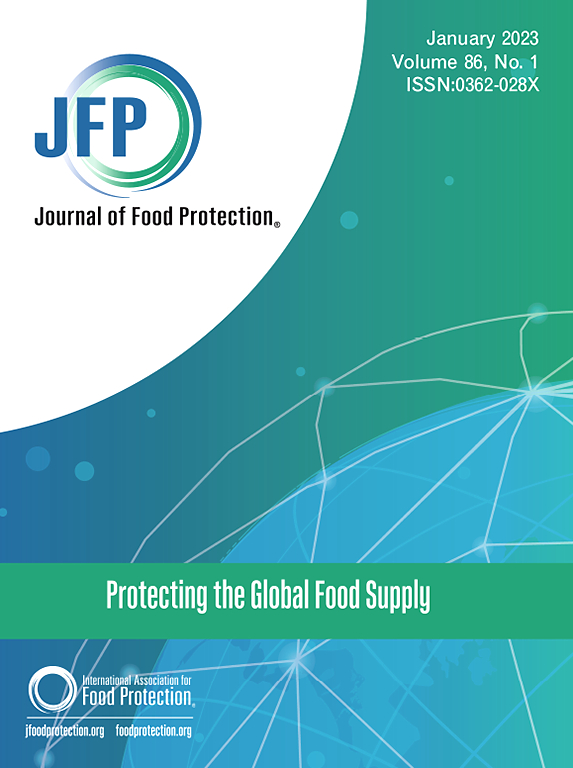The Combined Use of High Pressure Processing and Lactic Acid Containing Fermentate on Inactivation of Salmonella, Shiga Toxin-producing E. coli, and Listeria monocytogenes in Raw Pet Foods
IF 2.8
4区 农林科学
Q3 BIOTECHNOLOGY & APPLIED MICROBIOLOGY
引用次数: 0
Abstract
Raw meat pet foods can pose health risks to pets and humans. High-pressure processing (HPP) was used in a previous study to demonstrate its effectiveness in achieving a 5-log reduction of Salmonella, E. coli STEC, and L. monocytogenes in commercially available raw pet foods and maintaining the 5-log reduction throughout shelf-life with frozen storage being more effective than refrigerated. L. monocytogenes, being more HPP resistant, could potentially regrow when stored at refrigeration temperatures and required further optimization. Chicken-based raw diet pet food was inoculated with 7–8 log CFU/g cocktails of Salmonella spp., E. coli STEC, or L. monocytogenes and stored at 4 °C for 24 h before the addition of either 0.7% or 1.0% w/v lactic acid fermentate (LAF) and HPP treated at 586 MPa for 2, 3, and 4 min after 24 or 72 h storage at 4 °C. HPP-treated products were stored frozen (−10 to −16 °C) up to 21 days with microbiological analyses on days 1, 3, 5, 7, 14, and 21. All HPP-and LAF-treated samples demonstrated a 5-log reduction of Salmonella spp., E. coli STEC, and L. monocytogenes. Samples without LAF and HPP treated after 24 h storage at 4 °C resulted in an average 4.02 log cfu/g reduction of L. monocytogenes with 2 min HPP hold time while longer HPP hold times at 4 min improved L. monocytogenes reduction by 0.35 log cfu/g. E. coli was found to be more HPP resistant in this study than L. monocytogenes and the addition of LAF had a significant impact on the overall pathogen survival during post-HPP storage. Based on qualitative enrichment data for each pathogen, the use of LAF resulted in more complete inactivation compared to samples without LAF. The use of 1% LAF in combination with 586 MPa for 4 min was found to be most effective for the inactivation of Salmonella spp., E. coli STEC, and L. monocytogenes. The findings are significant as it provides both formulation and processing controls to ensure the safety of raw diet pet foods.
高压处理和含乳酸发酵剂联合使用对生宠物食品中沙门氏菌、产志贺毒素大肠杆菌和单核细胞增生李斯特菌的灭活作用。
生肉宠物食品会给宠物和人类带来健康风险。在之前的一项研究中,高压处理(HPP)被证明可以有效地将市售生鲜宠物食品中的沙门氏菌、大肠杆菌 STEC 和单核细胞增生性酵母菌的含量降低 5 个菌落,并在整个保质期内保持 5 个菌落的降低量,冷冻储存比冷藏储存更有效。单核细胞增生梭状芽孢杆菌对 HPP 的抵抗力较强,在冷藏温度下储存可能会重新生长,因此需要进一步优化。在以鸡肉为原料的宠物食品中接种 7-8 log CFU/g 的沙门氏菌属、大肠杆菌 STEC 或单核细胞增生梭菌鸡尾酒,并在 4°C 下存放 24 小时后,再添加 0.7% 或 1.0% w/v 的乳酸发酵剂 (LAF),并在 4°C 下存放 24 或 72 小时后,在 586 MPa 下进行 2、3 和 4 分钟的 HPP 处理。经 HPP 处理的产品冷冻保存(-10 至 -16°C)21 天,并在第 1、3、5、7、14 和 21 天进行微生物分析。所有经 HPP 和 LAF 处理的样品中的沙门氏菌属、大肠杆菌 STEC 和单核细胞增生性酵母菌均减少了 5 个菌落。未经 LAF 和 HPP 处理的样品在 4°C 储存 24 小时后,经 2 分钟 HPP 保持时间后,单核细胞增生奈氏菌平均减少了 4.02 log cfu/g,而经更长的 HPP 保持时间(4 分钟)后,单核细胞增生奈氏菌减少了 0.35 log cfu/g。在本研究中发现,大肠杆菌对 HPP 的耐受性高于单核细胞增多性肠杆菌,添加 LAF 对 HPP 后贮藏期间病原体的总体存活率有显著影响。根据每种病原体的定性富集数据,与不添加 LAF 的样品相比,使用 LAF 能更彻底地灭活病原体。在灭活沙门氏菌属、大肠杆菌 STEC 和单核细胞增生性酵母菌方面,使用 1%的 LAF 并结合 586 兆帕持续 4 分钟最为有效。该研究结果意义重大,因为它提供了配方和加工控制方法,以确保生食宠物食品的安全性。
本文章由计算机程序翻译,如有差异,请以英文原文为准。
求助全文
约1分钟内获得全文
求助全文
来源期刊

Journal of food protection
工程技术-生物工程与应用微生物
CiteScore
4.20
自引率
5.00%
发文量
296
审稿时长
2.5 months
期刊介绍:
The Journal of Food Protection® (JFP) is an international, monthly scientific journal in the English language published by the International Association for Food Protection (IAFP). JFP publishes research and review articles on all aspects of food protection and safety. Major emphases of JFP are placed on studies dealing with:
Tracking, detecting (including traditional, molecular, and real-time), inactivating, and controlling food-related hazards, including microorganisms (including antibiotic resistance), microbial (mycotoxins, seafood toxins) and non-microbial toxins (heavy metals, pesticides, veterinary drug residues, migrants from food packaging, and processing contaminants), allergens and pests (insects, rodents) in human food, pet food and animal feed throughout the food chain;
Microbiological food quality and traditional/novel methods to assay microbiological food quality;
Prevention of food-related hazards and food spoilage through food preservatives and thermal/non-thermal processes, including process validation;
Food fermentations and food-related probiotics;
Safe food handling practices during pre-harvest, harvest, post-harvest, distribution and consumption, including food safety education for retailers, foodservice, and consumers;
Risk assessments for food-related hazards;
Economic impact of food-related hazards, foodborne illness, food loss, food spoilage, and adulterated foods;
Food fraud, food authentication, food defense, and foodborne disease outbreak investigations.
 求助内容:
求助内容: 应助结果提醒方式:
应助结果提醒方式:


